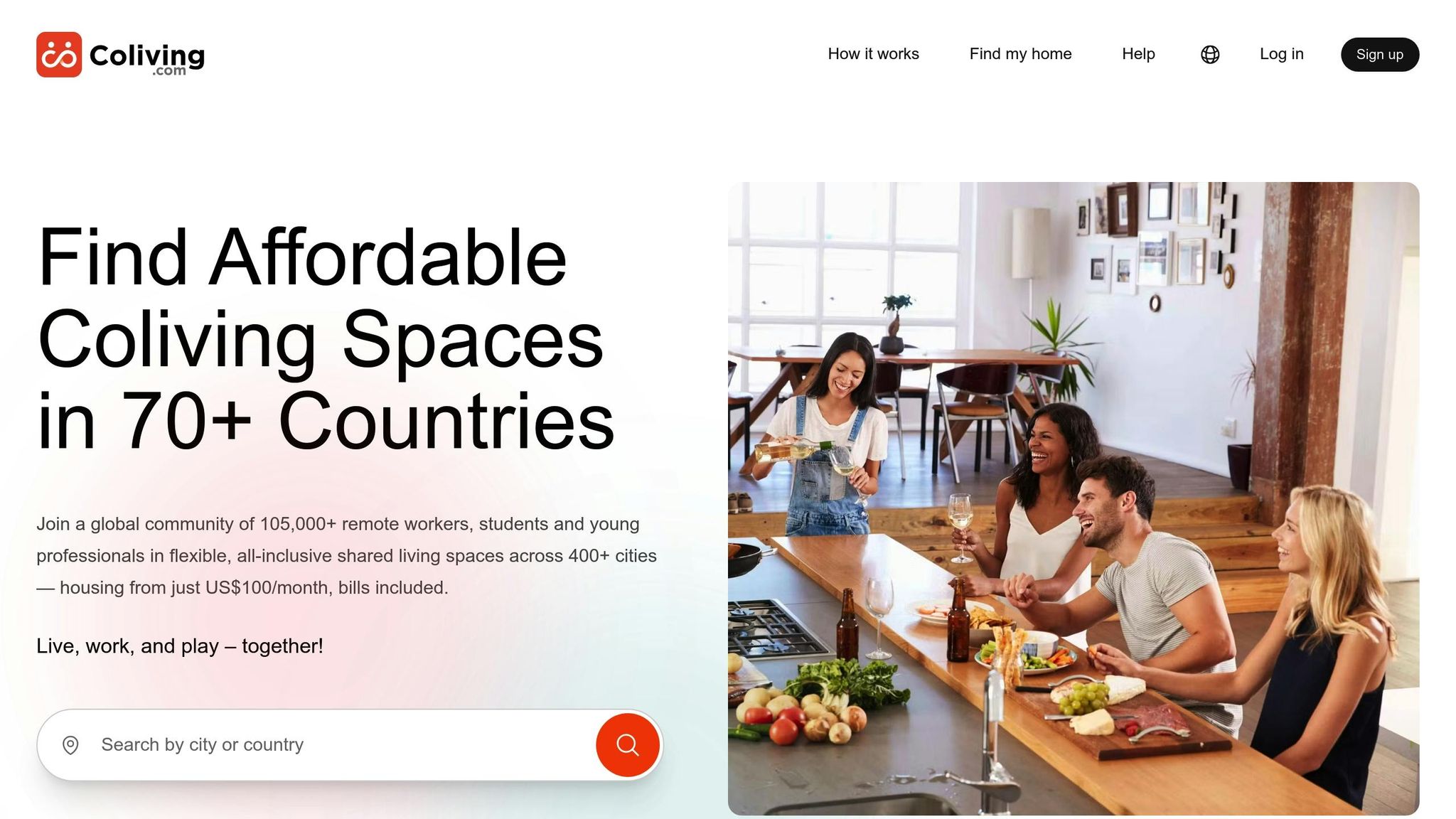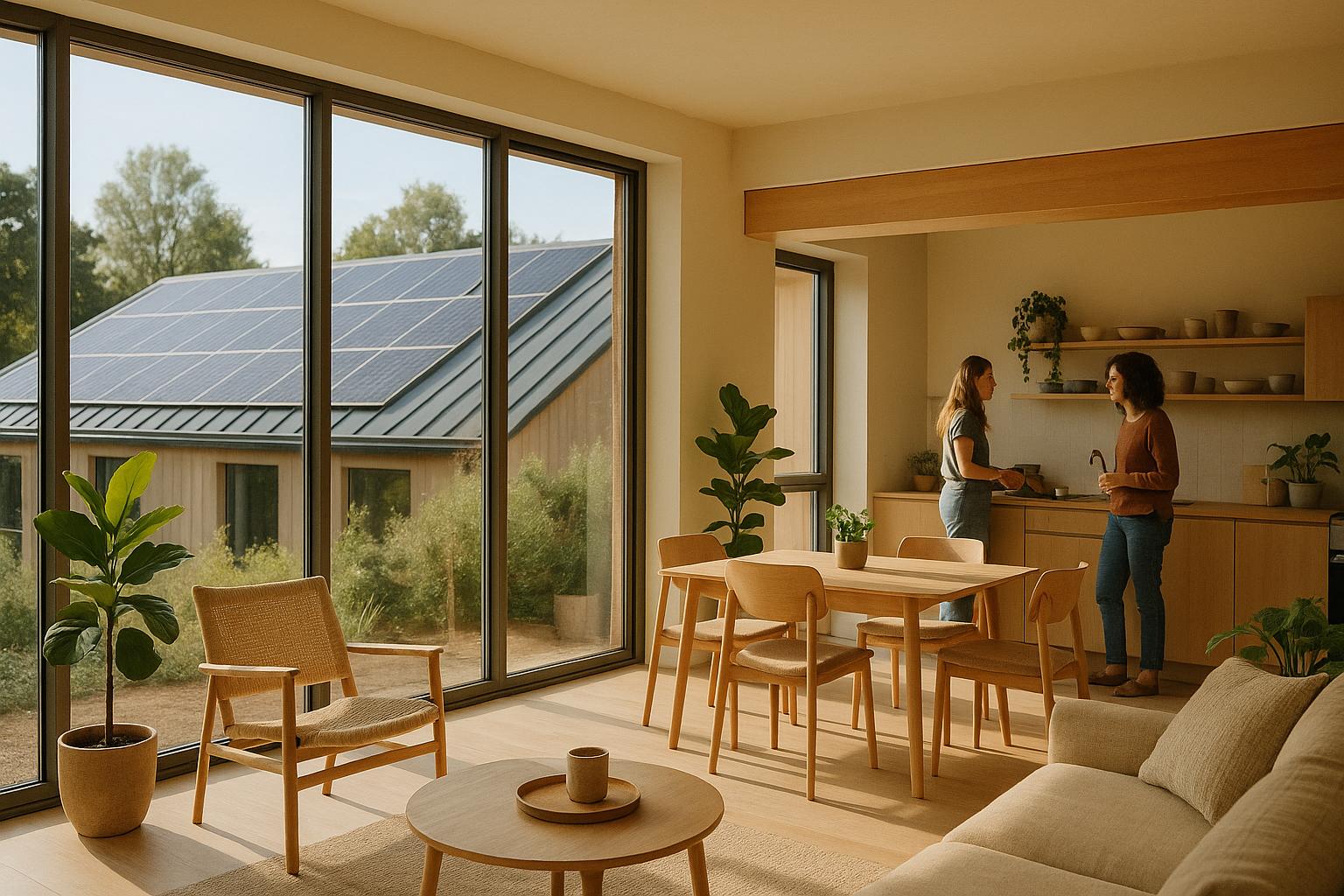Purpose-driven communities are reshaping how people live by combining shared housing with common goals and values. These spaces prioritize connection, collaboration, and a sense of mission, offering more than just a place to live. Residents engage in structured activities, from skill-sharing to group projects, creating meaningful relationships and a shared sense of purpose.
Key highlights:
- What they are: Housing spaces built around shared missions (e.g., sustainability, professional growth, or social impact).
- Who they attract: Young professionals seeking alignment with personal values and deeper connections.
- How they work: Residents actively participate in governance, shared responsibilities, and community activities.
- Why they’re growing: They address isolation, support eco-friendly living, and provide networks for personal and professional growth.
These communities are transforming housing into a collaborative and value-driven experience, offering an alternative to traditional living arrangements.
Defining Purpose-Driven Communities
What Purpose and Intentional Living Mean
Purpose-driven coliving is all about aligning every detail - from the layout of the space to daily routines - with a clear mission and shared values. Unlike traditional housing, where neighbors might only exchange a quick hello, these communities thrive on connection and intentional design.
Intentional living takes this a step further, asking residents to actively choose how they want to live together. This means setting clear expectations for things like household responsibilities and personal growth. The idea isn't just to share a building but to create a space where people are united by shared values and mutual support.
What really sets these communities apart is accountability and active involvement. Residents commit to more than just living under one roof - they engage in the community's mission through regular meetings, workshops, and collaborative projects. Everything, from how meals are planned to how guests are welcomed, reflects the community's purpose.
These spaces also prioritize structured interactions over passive coexistence. For example, they might organize skill-sharing sessions where residents teach each other, group volunteer activities that align with their values, or joint projects that push the community's goals forward. This intentional approach creates an environment where meaningful connections flourish.
By defining these intentions and putting them into practice, purpose-driven communities operate in a way that feels deliberate and unique.
How Purpose-Driven Communities Work Differently
These guiding principles reveal why purpose-driven coliving spaces function so differently from typical shared living arrangements. While traditional setups often focus on splitting costs and basic compatibility, these communities demand a deeper level of commitment and alignment with shared values.
Even the process of joining reflects this difference. Potential residents typically go through interviews or applications that evaluate more than just financial readiness. Communities want to know if applicants align with their mission, are willing to contribute, and can bring something meaningful to the group. Candidates might be asked to share their values, explain how they’d support the community’s goals, or highlight relevant skills.
Governance is collaborative, often involving resident councils, rotating leadership roles, and consensus-based decision-making. This shared responsibility fosters a sense of ownership and investment that goes far beyond the typical landlord-tenant relationship.
The physical design of these spaces also stands out. Shared areas are prioritized over private ones. Think large kitchens designed for group meals, dedicated spaces for workshops or meetings, and flexible rooms for community activities. Private bedrooms tend to be smaller, while communal spaces are thoughtfully designed to encourage collaboration and interaction.
Resource sharing is another hallmark of these communities. Beyond splitting utilities, residents often share tools, vehicles, equipment, or even professional spaces like coworking areas or studios. This approach not only reflects the community’s values but also provides practical benefits that individuals might not afford or access on their own.
Financial structures can also differ significantly. Some communities operate as housing cooperatives, where residents hold ownership stakes. Others use income-based rent models, focusing on accessibility rather than profit. The goal shifts from individual financial gain to creating fair, sustainable living arrangements that support the community’s overarching mission.
Why Purpose-Driven Communities Are Growing
As people across the U.S. rethink how they live, purpose-driven communities are stepping in to address two pressing needs: reducing social isolation and embracing eco-conscious living. More and more, individuals are seeking housing options that offer a sense of belonging and opportunities for collaboration.
The Need for Connection and Collaboration
With remote work reshaping daily life, many find themselves professionally connected but socially adrift. Working from home often lacks the camaraderie and community that traditional workplaces once provided.
Purpose-driven communities fill this void by creating spaces for meaningful interaction. Unlike typical roommate arrangements, where people might barely interact, these communities encourage connection through shared decision-making and collective activities.
The gig economy has also left many freelancers, entrepreneurs, and consultants without the organic networks that come with traditional jobs. Purpose-driven communities offer more than just a place to live - they provide professional networks where residents can share skills, collaborate on projects, and support one another.
For young professionals who move frequently, finding a reliable social circle can be challenging. While most apartment searches focus on location and cost, these communities offer an extra perk: an instant network of like-minded individuals. In bustling cities, this can be a game-changer.
By pooling resources, expertise, and efforts, residents in these communities create an environment where personal and professional goals are easier to achieve. This collaborative spirit naturally extends to shared commitments, such as living in a way that’s kinder to the planet.
Focus on Sustainability and Environmental Responsibility
A growing awareness of environmental issues is another major draw for purpose-driven communities. Many residents are committed to eco-friendly living and work together to make sustainable practices part of everyday life.
Shared living arrangements help reduce individual environmental impact by making better use of resources. When people share appliances, utilities, and common spaces, overall energy and material consumption drops compared to living separately.
Some communities go a step further by including sustainability guidelines in their agreements, ensuring that eco-conscious habits remain a collective priority. Mentorship programs within these communities often teach residents advanced techniques for green living.
Pooling resources doesn’t just benefit the planet - it also saves money. Shared utilities and group buying power can significantly lower costs, which appeals to those looking to live more affordably.
Transportation is another area where these communities shine. Many are located in walkable neighborhoods or near public transit, reducing the need for personal vehicles. Shared bicycles or electric vehicles provide additional options for environmentally friendly commuting.
These communities often become hubs for learning about sustainability. Workshops on topics like urban gardening, renewable energy, and waste reduction equip residents with practical skills for eco-friendly living, ensuring these habits stick long-term.
Core Values and Structure of Purpose-Driven Coliving Spaces
Purpose-driven communities revolve around shared principles that guide daily life and decision-making. These values aren't just decorative slogans - they're woven into how residents interact, collaborate, and grow together. This structured approach, rooted in intentional living, strengthens bonds and creates a deeper sense of belonging. By understanding these values and how these communities are organized, it becomes clear why they foster such strong connections and lasting impact.
Key Values: Connection, Inclusivity, and Growth
These communities thrive on three core values that shape their identity and daily practices.
Connection is at the heart of purpose-driven coliving spaces. Unlike traditional housing where neighbors may only share polite greetings, these communities focus on building meaningful relationships. Residents connect through shared meals, regular meetings, and group projects, creating a sense of family. This value is reflected in the design of the spaces - communal kitchens encourage group cooking, shared living areas spark conversations, and planned activities naturally bring people together.
The idea of connection goes beyond personal relationships. Many residents find professional opportunities within the community, such as mentors, collaborators, or even business partners. This blend of personal and professional networking makes these spaces more than affordable housing - they become hubs of growth and opportunity.
Inclusivity is another cornerstone, ensuring that people from various backgrounds and perspectives feel welcome and valued. These communities actively celebrate diversity, recognizing that different viewpoints enhance creativity and problem-solving. Inclusivity is evident in practices like selecting residents from diverse backgrounds, hosting cultural events, and creating policies that support various lifestyles.
Practical steps include sliding-scale rent options based on income, accommodations for dietary needs, and flexible living arrangements for families of different structures. These efforts break down barriers, allowing people from different economic and social backgrounds to coexist and thrive together.
Growth, both personal and professional, forms the third pillar of these communities. Residents support one another through workshops, skill-sharing sessions, and collaborative projects. This might involve language exchange programs, creative endeavors, or professional development opportunities. These shared experiences encourage individuals to push their boundaries and discover new interests.
The community itself also embraces a growth mindset. Regular feedback sessions provide a platform for residents to suggest improvements, helping the community evolve and adapt. This dynamic environment ensures that both individuals and the collective continue to grow and improve over time.
Governance and Community Agreements
The core values of these spaces directly shape their governance, ensuring that the community functions harmoniously while staying true to its mission. Decision-making often relies on consensus, giving everyone a voice in shaping the community's future.
Community agreements act as a guiding framework, outlining expectations for daily life. These agreements go beyond traditional lease terms, focusing on mutual respect, shared responsibilities, and conflict resolution. They cover everything from cleaning schedules and noise guidelines to guest policies and dispute management. This emphasis on collaboration fosters trust and accountability among residents.
Leadership roles are often rotated, encouraging everyone to take responsibility and develop management skills. This shared responsibility ensures that the community thrives while giving individuals the chance to grow as leaders.
Financial transparency and clear conflict resolution processes further strengthen trust within the group. Regular evaluation periods allow residents to assess how well the community is meeting its goals and to propose changes. This continuous improvement not only keeps the community aligned with its values but also ensures it remains flexible and responsive to new challenges.
How to Join or Create a Purpose-Driven Community
If you're looking to dive into a meaningful shared living experience, joining or building a purpose-driven community could be the perfect step. Whether you're seeking to connect with an established group or start your own, having a clear plan and understanding your goals will make the process smoother. Thanks to modern tools and resources, this journey is more manageable than ever.
Steps to Research and Join a Community
Start by identifying your values and goals. Are you drawn to causes like environmental initiatives, creative collaboration, or professional networking? Knowing what you care about will help you find communities that align with your aspirations. Also, consider whether you prefer structured environments with set routines or more flexible, laid-back arrangements. These preferences will guide your search.
Do your homework before applying. Many purpose-driven communities have active websites or social media channels where they share updates about their mission, values, and resident activities. Look for spaces that frequently post about their projects or highlight their members - this often signals an engaged and transparent community.
Check out their governance structures and community agreements. These documents reveal how the community functions daily and whether their approach fits your preferences.
Understand the application process upfront. Applications typically involve writing essays about your values, goals, and the contributions you plan to make. Some communities may also require video interviews or references from former roommates or collaborators.
Think about past experiences that showcase your commitment to group living, like volunteering, organizing events, or supporting others. These examples can help you stand out during interviews.
Visit in person whenever possible. While online research is helpful, nothing beats experiencing a community firsthand. Many spaces offer trial stays, guest visits, or open events for prospective members. These visits give you a sense of the community’s vibe and whether it feels like a good fit.
When visiting, observe how people interact during meals, meetings, or casual moments. Do conversations feel genuine? Are residents engaged in the community’s mission? Trust your instincts about whether you feel comfortable and excited about the possibility of living there.
Using Coliving.com for Easy Booking

Once you’ve found a community that aligns with your values, platforms like Coliving.com can simplify the search and booking process. This site connects you to over 1,900 coliving spaces in 380 cities across 70+ countries. You’ll find detailed profiles for each community, making it easier to compare options and find the right fit for your lifestyle.
Instead of juggling multiple websites or endless email chains, Coliving.com lets you review amenities, compare communities, and even handle rental agreements - all in one place. This is especially helpful if you’re exploring several options or planning a move to a new city.
Each listing includes key details like community values, rules, and resident demographics, along with photos of shared spaces, private rooms, and the surrounding neighborhood. This transparency helps you make informed decisions without wasting weeks researching.
Flexible terms and included amenities make moving in easier. With options starting at $100 per month, the platform caters to a variety of budgets while maintaining quality standards.
The site also offers perks like a money-back guarantee and simple cancellation policies, giving you peace of mind when trying out a new community. If things don’t work out, you can transition to another space without major financial risks.
Coliving.com’s network of 750 hosts ensures consistent quality across its listings. This vetting process helps you avoid poorly managed spaces and focus on finding communities with clear values and strong organization.
Tips for Building Your Own Purpose-Driven Space
If you don’t find a community that fits your vision, why not create your own? Here’s how to get started:
Define your mission clearly. Every successful purpose-driven community begins with founders who can articulate their vision. What gap are you aiming to fill? Whether it’s promoting sustainability, fostering creative collaboration, or advancing professional growth, your mission should be specific enough to attract like-minded people but inclusive enough to welcome diverse perspectives.
Share your mission statement with potential co-founders to establish a solid foundation for decisions about structure, resident selection, and daily operations.
Start small and grow naturally. Many thriving communities begin with just a handful of committed individuals sharing a house or apartment. Starting small allows you to test governance structures, fine-tune agreements, and build trust among members before expanding.
Consider running a six-month pilot with close friends or colleagues who share your vision. Use this time to experiment with shared meals, decision-making processes, and conflict resolution strategies. Learn from your successes and challenges before scaling up.
Set up clear financial and legal systems. Even purpose-driven communities need solid financial management and legal protections. Create transparent systems for rent, shared expenses, and community investments. It’s a good idea to consult a lawyer with experience in cooperative housing to draft agreements.
If inclusivity is a priority, consider sliding-scale rent options or work-exchange programs. Just ensure these arrangements are sustainable and don’t cause tension among residents paying different amounts.
Invest in ongoing community development. Strong communities don’t just happen - they’re built through regular activities that strengthen relationships and advance shared goals. Plan weekly meals, monthly feedback sessions, and quarterly meetings to set and review objectives. Encourage residents to take the lead on workshops, events, or other projects.
Create clear systems for welcoming new members and helping them integrate into the community. This could include mentorship programs, orientation sessions, or a gradual introduction to responsibilities. A thoughtful onboarding process goes a long way toward building a cohesive and satisfied group.
The Future of Purpose-Driven Communities in the United States
Purpose-driven communities are shaping up to be a key part of the American housing landscape in the years ahead. With traditional homeownership facing persistent hurdles, these intentional living setups offer a fresh alternative that addresses both financial and social needs. Rising housing costs, changing work patterns, and a growing desire for authentic connections are fueling their growth. These trends align with the values and structures already discussed, paving the way for continued evolution.
Evolving to Fit American Lifestyles
These communities are transforming to better match the shifting needs of American residents. Purpose-driven living spaces are finding ways to blend the need for personal privacy with the perks of shared environments. Many designs strike a balance, offering private areas for solitude alongside communal spaces geared toward work, relaxation, and social interaction. As flexible work becomes more common, some communities are incorporating adaptable workspaces to meet this demand. While these innovative living models initially took root in large cities, they are now gaining traction in smaller towns and suburban areas, where residents value both affordability and access to local amenities. Flexible leasing options cater to a mobile workforce, while efforts to integrate with surrounding neighborhoods create a richer, more connected living experience.
Focusing on Meaningful Living
At their core, these communities remain committed to fostering sustainability, personal growth, and social impact. Residents are drawn to opportunities for self-improvement and environmentally conscious practices. Programs that encourage intergenerational connections, prioritize mental health through group activities and wellness initiatives, and provide accessible support services add depth to the communal experience. While technology plays a role in simplifying tasks and communication, it is used to complement - not replace - face-to-face interactions. Additionally, new economic models and regulatory changes suggest that purpose-driven communities will continue to adapt and thrive, offering solutions for a variety of American lifestyles.
These communities present a fresh, flexible, and socially connected alternative, making them an appealing option for those navigating modern housing challenges in the United States.
Conclusion: The Potential of Purpose-Driven Communities
Purpose-driven communities are reshaping the concept of shared living by bringing people together around meaningful goals that address feelings of isolation and disconnection.
These communities go beyond simply offering affordable housing. They create environments where shared values and daily interactions foster deep connections, turning everyday moments into opportunities to build a collective vision. This type of engagement moves past surface-level participation, creating genuine bonds among residents.
With a clear structure - focused on defining purpose, aligning personal and community goals, and establishing ways for everyone to contribute - these communities create a sense of unity. They transform individuals into a tightly connected group, making shared living a truly enriching experience.
Across the United States, these communities are evolving, offering an answer to isolation and shallow interactions while addressing the deeper human need for connection and purpose. Whether you're considering joining one or starting your own, this approach to living presents a powerful way to combine personal growth with collective strength.
As housing trends shift, these intentional communities are becoming a vital option, where residents don't just share a roof - they share a mission, laying the groundwork for stronger, more resilient communities and personal well-being.
FAQs
What are the key advantages of living in a purpose-driven community compared to traditional housing?
Living in a community built around shared purpose offers benefits that go far beyond the typical housing experience. These neighborhoods are thoughtfully created to encourage authentic connections, uniting people who share similar values, interests, and aspirations. The result? A strong sense of belonging and mutual encouragement.
Another key focus is on sustainable and intentional living. Residents are often encouraged to make environmentally conscious decisions and participate in collaborative efforts that align with their way of life. These communities also provide a space where personal growth and creativity can flourish, offering countless opportunities to learn, work together, and thrive in an environment that supports exploration and innovation.
Unlike conventional housing, purpose-driven communities are designed around meaningful relationships and shared goals, making them an ideal choice for those craving deeper bonds and a more enriching way of life.
How do purpose-driven communities make sure residents share their mission and values?
Purpose-driven communities thrive by establishing a clear mission and set of values right from the beginning. This clarity not only gives members a shared sense of direction but also draws in like-minded individuals who align with the community’s vision.
They maintain this alignment through consistent communication, hosting regular events, and organizing collaborative activities. These efforts create a space where members feel truly connected and invested, fostering a sense of belonging and encouraging active, meaningful participation.
How can I start my own purpose-driven community, and what challenges should I be prepared for?
Starting a purpose-driven community starts with defining a clear mission that reflects shared values and goals. It's all about understanding what your potential members need and forming genuine connections with them. To get started, focus on shaping a strong vision, fostering open and honest communication, and creating spaces - whether physical or online - where collaboration and inclusivity can flourish.
Of course, building such a community comes with its challenges. You might encounter issues like mission drift, member burnout, or struggles with financial sustainability. Balancing your purpose with the practicalities of running a community and ensuring everyone feels included can also be tricky. Tackling these obstacles takes consistent effort, flexibility, and open communication. With a solid foundation and a shared purpose, your community can grow and succeed.






